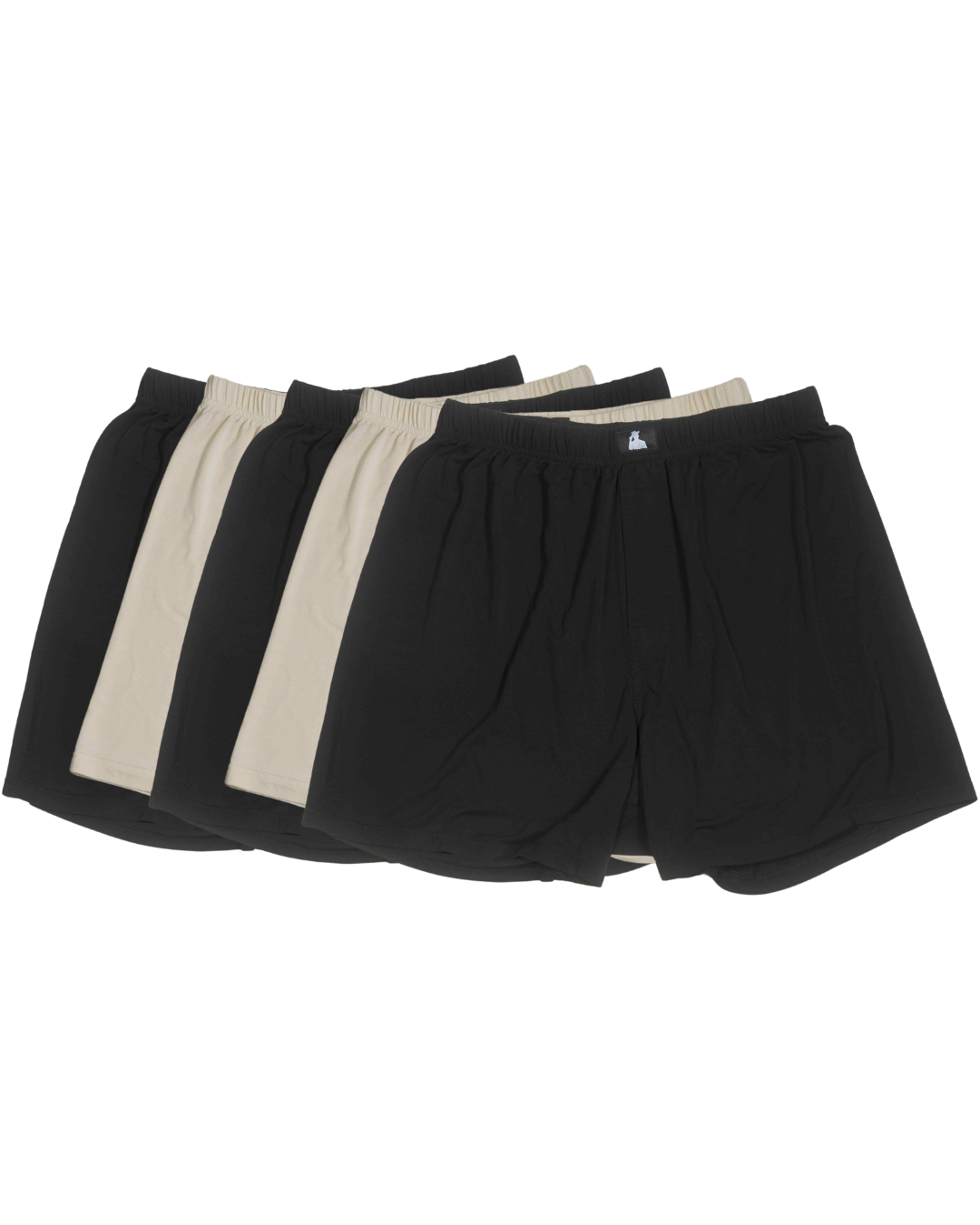What Is Fertilitywear? The Emerging Category Putting Reproductive Health First
Written By The Mr. Fertyl Research & Education Team
What is fertilitywear? Fertilitywear refers to clothing – especially men’s underwear – designed to support reproductive health. In practical terms, it means apparel made with materials and designs that prioritize things like healthy sperm production, hormonal balance, and overall comfort for the reproductive organs. Think of it as an emerging men’s wellness category in fashion: just as activewear is optimized for exercise, fertilitywear is optimized for fertility. This concept has arisen in response to growing concerns about male reproductive health and the factors in our environment that may be undermining it.
Why Focus on Male Fertility?
Male fertility is an important (yet sometimes overlooked) part of the equation when couples are trying to conceive. In fact, male factors are involved in about half of infertility cases [7]. However, talking about sperm count or testicular health hasn’t exactly been mainstream. Historically, fertility conversations often centered on women, but times are changing. Doctors and researchers now emphasize that men’s reproductive health deserves just as much attention – and recent trends underscore why.
Studies over the past few decades have reported significant declines in sperm counts worldwide. One major review found that sperm concentrations in several regions (including North America and Europe) have dropped by roughly 50% over the last 40–50 years [11]. In plain language: the average man today has about half the sperm per milliliter of semen that his grandfather did. That’s a startling change, and it’s not just an academic concern – low sperm count can reduce the chances of conception.
What’s behind this global drop in sperm health? Researchers believe it’s not one single cause, but rather a mix of modern lifestyle and environmental factors. Exposure to endocrine-disrupting chemicals (EDCs) is often cited as a major culprit. These are chemicals that interfere with our hormones – and hormones play a huge role in reproductive function. Since the mid-20th century, industrial and consumer chemicals like phthalates (used in plastics and fragrances) and bisphenol-A (BPA) have become ubiquitous. It’s likely not a coincidence that as these hormone-hijacking chemicals proliferated in our environment, male fertility metrics worsened [1][11]. Research has linked EDC exposure to lower testosterone, poorer semen quality, and even damage to sperm DNA [2][5]. In other words, the modern world is full of unseen toxins that can subtly chip away at male reproductive health over time.
Of course, chemical exposure isn’t the only factor. Lifestyle matters too – diet, stress, smoking, and even heat exposure to the testicles can all affect fertility. You may have heard the age-old advice to switch from tight briefs to looser boxers; there’s actually science behind that. Because the testes function best a bit cooler than core body temperature, anything that consistently warms them up can impair sperm production. One prominent study of 656 men at Harvard found that those who usually wore loose-fitting boxers had 25% higher sperm concentration and 17% higher total sperm count than men who wore tight jockeys or briefs [10]. The men in boxers literally produced more sperm, likely thanks to cooler conditions. Many urologists therefore recommend simple measures like wearing breathable underwear and avoiding frequent hot tubs to men looking to optimize their fertility [6]. While switching underwear alone won’t turn everything around, it can be one piece of a fertility-friendly lifestyle.
All of this context – from declining sperm counts to the effects of heat and chemicals – sets the stage for fertilitywear. The idea is that if certain habits and exposures can hurt male fertility, then perhaps our everyday clothing choices can help protect it. Fertilitywear is about being proactive and health-conscious in an area men haven’t traditionally given much thought to: their underwear drawer.
From Tight Synthetics to Fertility-Friendly Fabrics
Take a moment to consider the typical pairs of men’s underwear sold in stores. Many are made of synthetic blends or traditional cotton treated with dyes and finishes. They might be tight-fitting, non-breathable, and even infused with chemicals (for example, some “anti-odor” or moisture-wicking sports underwear use antimicrobial treatments or plastics). Unfortunately, those qualities can be less than ideal for reproductive health. Tight, non-breathable fabric can lead to increased scrotal temperature, which, as we discussed, may reduce sperm production [6]. And chemicals present in the fabric? If they include certain EDCs (like phthalates used in elastic prints or flame-retardant additives), they could potentially leach or absorb through the skin over time [8]. It’s a double-whammy many men don’t think about – heat stress and chemical exposure right where it matters most.
Fertilitywear aims to change that. It starts with smarter material choices. One material gaining attention in this space is Bamboo Lyocell, dubbed a “fertility-friendly fabric.” Bamboo Lyocell is a fabric made from bamboo plant fibers, but with a modern twist: it’s produced via a closed-loop process that uses non-toxic solvents (unlike traditional viscose). In essence, bamboo is broken down into a pulpy solution and then spun into fibers without the nasty chemicals that older rayon processes used. The result is a silky-soft, breathable textile that retains none of the harmful residues you might find in conventional synthetic fabrics [9]. Manufacturers recover and reuse >99% of the solvent, so the process is very clean. No formaldehyde finishes, no chlorine bleach residues – just smooth bamboo-based fiber.
So why is Bamboo Lyocell great for reproductive health? First off, it’s extremely soft and breathable, which means it’s gentle on the skin and doesn’t trap heat. In fact, Lyocell is about 50% more absorbent than cotton [9], helping wick away moisture and keep things cool and dry down there. Many men find that bamboo-based underwear feels “barely there” because it’s so lightweight and doesn’t cling or chafe. This level of comfort isn’t just a luxury; it actively contributes to a better environment for sperm. By preventing excessive warmth and humidity, a fabric like Bamboo Lyocell helps maintain an optimal climate for the testes (which could, in theory, support healthier sperm counts). It’s the opposite of those suffocating, sweaty polyester briefs that leave you overheated.
Secondly, Bamboo Lyocell is free of harmful toxins by design. The fabric can be made to meet stringent safety standards (such as OEKO-TEX® certification) ensuring it contains no residues of pesticides, heavy metals, or irritants. Remember those chemical culprits we talked about? Bamboo Lyocell gives them the boot. You won’t find added formaldehyde (used to make clothes wrinkle-free) or phthalate-laden plastic prints on a pair of pure bamboo Lyocell underwear. By choosing clean, toxin-free materials, fertilitywear reduces one more potential source of endocrine disruptors in daily life. It’s a small victory: less contact with hormone-harming chemicals for hours on end each day.
Finally, an important bonus: sustainability. Part of putting “reproductive health first” is also thinking long-term about the planet we’re reproducing on. In that regard, Bamboo Lyocell is a rockstar compared to conventional fabrics. Bamboo grows rapidly without the need for irrigation or much pesticide, and it yields a lot of fiber per acre. The Lyocell production process is eco-friendly with its closed-loop solvent recycling [9]. According to the fabric makers, producing Lyocell uses less than half the water of equivalent cotton fabric [9]. And since it’s plant-derived, it’s biodegradable at the end of its life. So, fertilitywear isn’t just good for your future family – it’s considerate of future generations in general. It marries personal health with environmental health.

Worn Daily. Make It Count.
Upgrade Your EverydayMeet Mr. Fertyl: Fertilitywear in Action
All these concepts might sound great in theory, but how do they look in practice? Let’s consider an example. Mr. Fertyl is one of the pioneering brands in the fertilitywear space. In non-technical terms, our underwear is made with a super-soft bamboo fabric with a touch of stretch – and even the waistband (elastane) is wrapped in Bamboo Lyocell so it never directly touches your skin. The design checks all the fertility-friendly boxes: ultra-breathable, cooling, non-toxic, and comfortable for daily wear.
Strategically, Mr. Fertyl’s underwear is created to keep you comfortable and confident while quietly looking after your reproductive health. The fabric’s breathability means your testicles can “breathe” too, staying at a happy temperature. The absence of harsh chemicals means you’re not exposing some of the most sensitive parts of your body to potential endocrine disruptors every day. And because the material is so smooth and irritation-free, you’re more likely to actually enjoy wearing them – making it easy to stick with healthier habits. In a sense, it’s preventative healthcare that doesn’t feel like a chore: you just put on your boxers in the morning as usual, and they happen to be looking out for you.
Importantly, fertilitywear doesn’t look any different from regular underwear. Mr. Fertyl’s underwear, for example, have a modern, stylish cut and come in attractive colors – there’s no clinical or gimmicky appearance. This is deliberate. The goal is to normalize conversations around male fertility and encourage men to take pride in proactive self-care. By blending into your everyday wardrobe, fertility-focused clothing can become just another aspect of wellness, like choosing healthy food or using skincare with clean ingredients. There’s a growing movement in men’s health to be open and proactive about issues like fertility, and having products like these on the market helps make that conversation feel normal and even empowering.
Comfort, Health, and Sustainability – All in One Package
The emergence of fertilitywear underscores a broader point: you shouldn’t have to compromise. Men deserve underwear that is comfortable, supports their reproductive health, and is environmentally responsible. These factors actually complement each other. A pair of boxers that keeps you cool and chemical-free is inherently going to be comfier than one that doesn’t. And if it’s made from sustainable bamboo rather than conventionally grown cotton or petrochemical fibers, that’s a win for everyone.
In the past, men might not have given a second thought to what their boxers were made of – cotton, polyester, whatever was on sale. Now, as we learn more about the impact of everything from heat to hidden chemicals, it makes sense to be a bit choosier. Fertilitywear is about making that choice easy. It says: Here’s a pair of underwear that feels great, and by the way, it might help keep your sperm happy too. For someone planning to start a family (now or in the future), that’s a reassuring bonus. And even for those who aren’t, the general health benefits (less exposure to toxins, more comfort) are still well worth it.
In talking about fertilitywear, we also help chip away at the stigma or awkwardness surrounding male fertility. There’s nothing un-masculine about caring for your health – quite the opposite! Just as wearing sunscreen or going to the gym is seen as responsible, choosing fertility-friendly clothing is simply a smart way to take care of yourself. When brands like Mr. Fertyl put reproductive health front and center, it invites more men to join the conversation. Suddenly, terms like sperm count, hormonal balance, or endocrine disruptors enter everyday chatter in a practical, solution-oriented way. The tone is friendly and empowering, not fear-mongering.

Your Reproductive Health Deserves Better. Seriously.
Switch to Fertilitywear™Breaking the Taboo
By embracing fertilitywear, men can take charge of their reproductive well-being without making a big fuss – it’s as easy as pulling on a different pair of shorts. Over time, small changes in habits (like what underwear you wear) could add up, especially when combined with other healthy choices (balanced diet, avoiding tobacco, managing stress, etc.). Think of fertility-friendly underwear as one tool in your toolbox for reproductive health. It’s not a magic cure-all, but it aligns with doctors’ advice to avoid unnecessary heat and toxins in order to protect fertility [6]. And at the very least, you get a really comfy pair of undies out of the deal.
The Bottom Line
Male fertility is finally getting the attention it deserves, and fertilitywear is a tangible result of that shift. It represents an intersection of science, health, and fashion – proof that even our clothing can adapt to put our well-being first. So if you’ve been wondering how to support your sperm (or just improve your undergarment game), consider giving fertilitywear a try. Choosing options like Bamboo Lyocell underwear is a simple step that can help keep “the boys” cool, comfortable, and free from harmful chemicals. In doing so, you’re not only investing in your own health, but also joining a new normal where men openly take charge of their reproductive health. And who knows – that could make a world of difference for you and your future family.
- Swan, S.H. & Colino, S. (2021). Reproductive Problems in Both Men and Women Are Rising at an Alarming Rate – Scientific American. Source.
- Wallis, C. (2023). Common Chemicals May Harm Sperm and Pregnancies, Growing Evidence Shows – Scientific American. Source.
- Levine, H. et al. (2022). Temporal trends in sperm count: a systematic review and meta-regression analysis – Human Reproduction Update. Source.
- Minhas, S. et al. (2020). Endocrine-disrupting chemicals and male reproductive health – Reproductive Medicine and Biology. Source.
- Jain, M., Carlson, K. & Singh, M. (2025). Environmental Toxins and Infertility – StatPearls (NIH/NLM). Source.
- Mayo Clinic Staff (2023). Male infertility: Symptoms and causes – Mayo Clinic. Source.
- Cleveland Clinic (2024). Male Infertility – Cleveland Clinic. Source.
- Wilson, J. (2022). Toxic Textiles: The Chemicals in Our Clothing – EarthDay.org. Source.
- Schibli, J. (2019). Pulp fabric: everything you need to know about lyocell – The Guardian. Source.
- Sample, I. (2018). Wearing boxer shorts boosts sperm count, scientists say – The Guardian. Source.
- Endocrine Society. (n.d.). Impact of EDCs on reproductive systems. Source.

